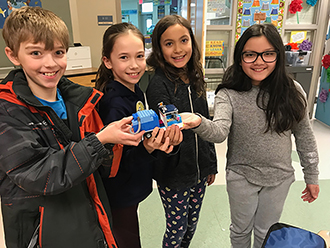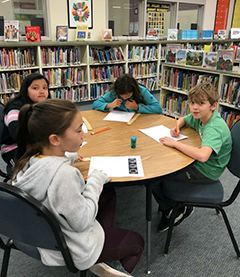Inspiring a Generation of Compassionate Leaders with ExploraVision
ExploraVision is a unique science competition because it inspires students to take a look at the world around them and think deeply about how it can be improved. What innovative ideas could be brought forth to positively impact their community and the lives of others? What drives them to make a change? These thought-provoking questions encourage young learners to adopt a compassionate worldview while also empowering them with the knowledge that they can make a difference.
Introducing ExploraVision in Your School
Our school offers the ExploraVision program to K-5 students who are interested in pursuing an academic, project-based learning experience after school. Through years of participation in the competition, we have found that students work best when they are grouped together by common interests. As a result, we provide extra time for students to create a bond with each other so they can form project teams that are the right fit for them. Once groups are formed, we introduce the ExploraVision timeline to assist students in remaining on schedule until the project completion phase. The next step in the process is brainstorming and ideation.
Building Compassion Through the Brainstorming Process
My students have very little trouble identifying problems to solve in their day-to-day lives. For instance, take the experience of our winning team, whose final project was titled: Leaves Changing Shapes (Relinquit Mutatio Figura). Our school and many of our homes are located near a noisy interstate highway. Students expressed how difficult it was to sleep at home or concentrate during the school day because of these consistent traffic sounds. Through sharing similar experiences of noise distraction, the team formulated their idea. The final decision to move forward with this project came when the team observed a classmate wearing large, awkward headphones to cancel out the noise. These students were filled with an overwhelming sense of compassion by placing themselves in the shoes of people who struggle with sensory issues, headaches, and pure frustration from noise pollution.

ExploraVision regional winners with their project model.
Once students find the cause that drives them to make a difference, they become visionaries on behalf of their ideas. Each classroom session becomes a time to share their project and receive feedback. They learn how to disagree with kindness and agree using evidence of their thinking. It is a genuinely collaborative learning process.
Keeping Students Motivated Throughout ExploraVision
The ExploraVision program is a long process, meaning students will likely tire at some point and require encouragement to push through. Be sure to make every classroom meeting a celebration of accomplishing items on the program checklist. At our school, we begin each session with a group circle to highlight these successes and to provide positive, supportive suggestions to help teams move forward with their ideas. It is also important to have the support of other teachers, parents, and the wider school community throughout the project. This way, every team knows they have many people to go to if they have questions or doubts.

Students working hard on their ideas.
Final Takeaways
Our regional-winning team was excited to see their hard work recognized by influential people from NSTA, and established scientists who validated their scientific thinking. Even without recognition, every student who participates in ExploraVision will feel empowered by the knowledge that they can make the world a better place. By inspiring young learners to make a difference, we can help build a future where communities no longer struggle with noise pollution, carbon dioxide, or disease. These students become ambassadors for today’s youth by spreading their experience and working hard towards their dreams of a brighter tomorrow.
Download these free K-12 STEM lesson plans to get started!
About the Author
Debbie Beck is an educator at Lee Elementary School in Salem, Oregon. She has mentored several ExploraVision teams, including a regional-winning team whose project tackled noise pollution. She believes the science competition is a great way to inspire students to adapt a compassionate worldview to make the world a better place.